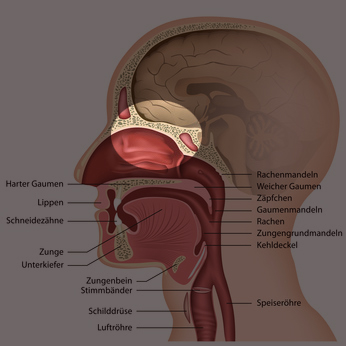Introduction video
Complaints
While the majority of people can enjoy the smell of good food, flowers or perfume, intense fragrances are torture for others. They trigger drowsiness, headaches, dizziness, tightness, anxiety and other functional disorders.
These people suffer from hyperosmia, an increased sensitivity to odors that is similarly debilitating to noise or light sensitivity. It is not uncommon for this to lead to avoidance of intense odors. Since odors and fragrances are virtually ubiquitous, this sometimes leads to severe social withdrawal and considerable suffering.
In the foreground of the symptomatology is an abnormal sensitivity to odors. Very strong sensitivity is usually to perfume, smoke, chemicals of all kinds (detergents, solvents, etc,), body odors, and food. Similarly, the sensitivity of the tongue may be increased: sharp, bitter or sour things are perceived as particularly unpleasant (burning, metallic taste).
Complaint Development
In the beginning, there is often an exposure to a certain unpleasant-smelling or threatening odor. Not infrequently, this takes place in an emotionally stressful situation. Subsequently, there is a slow lowering of the threshold for this odor. Smaller and smaller concentrations trigger a reaction.
In the further course, a generalization of the sensitivity occurs. Similar smelling substances also trigger discomfort. Over time, the triggers become more and more non-specific. In the end, increased sensitivity to "almost everything" may be present.
Primary symptoms
We distinguish primary from secondary symptoms in our work.
The sense of smell serves primarily for protection. Spoiled, poisonous food is extremely rare today, but it used to be common. So the position of the nose above the mouth does have a purpose! Also the warning of a fire, must or dangerous animals went quite substantially over the nose.
Thus, the primary reaction to such dangers is protection against ingestion of bad air or threatening food. Accordingly, we distinguish breath-related from food-related symptoms.
Breath-related protective reactions: Difficulty breathing, shortness of breath, coughing, asthmatic symptoms, itching in the throat, runny nose, burning eyes,dizziness, lightheadedness, feelings of anxiety (often caused bychronic hyperventilation).
Food-related protective reactions: Nausea, vomiting,stomach or intestinal painor cramps, bloating, flatulence, constipation, or diarrhea.
Secondary symptoms
If the disease progresses, further symptoms occur, which can also be attributed to the activation of further protective reflexes.
Difficulty falling asleep and especially sleeping through the night, general sensitivity to noise, light, touch, pressure, pain, cold, heat, vibration. Other functional syndromes such as irritable bladder syndrome, irritable bowel syndrome, fibromyalgia syndrome, dizziness and the like are strongly favored.
As a result, there is increasing fatigue, tiredness, poor performance, lack of concentration, and evenCFS-like exhaustion.
Being at the mercy = fear
Avoiding odors is often difficult because we cannot simply close our nose like our eyes or a window. For many affected people, the helplessness of not being able to avoid odors is therefore the most difficult aspect of hyperosmia. Due to the insufficient legal regulations regarding the declaration obligation, it is also hardly possible for them to recognize when buying a product whether they are being befuddled by fragrances at home.
Most people are not bothered by the multitude of artificial sensory impressions. On the contrary, they can enjoy music or scent and consciously use fragrances as "aromatherapy".
Biological principles
The olfactory nerves are located in the nasal mucosa, more precisely in the upper of the three nasal conchae. In contrast to feeling, seeing or hearing, the olfactory nerves are an advanced part of the brain, are part of the brain. This part of the brain is separated from the nasal cavity only by the thin, perforated ethmoid plate through which the sensory cells project into the air stream.
The olfactory nerve is one of the developmentally oldest parts of the brain and is part of the so-called limbic system, which determines our feelings.
In each of the two upper nasal conchae there is a sensitive area covering about 5 square centimeters (5 times that in dogs!). But that's not all: the nasal mucosa is simultaneously supplied by the trigeminal nerve over its entire area. It is responsible for the perception of pungent odors (warning signal!), e.g. ammonia.
Physiology
Even if we consider our own olfactory ability to be rather low compared to that of a dog, for example, the performance is still considerable.
- We have about 10-20 million olfactory sensors.
- We can distinguish about 10,000 different smells, and without training we can name about half of them. Through training, this rate can be increased considerably (towards 98%).
- In dogs, the odor threshold is one molecule per mm3 of air. In humans, this is much higher: we can perceive something from 10,000 molecules per mm3 of air.
- This means: we can already perceive one milligram of vanilla in a room 10x10x10 meters in size. And for a substance contained in garlic (methyl mercaptan) the threshold is much lower.
- We can still smell musk in a dilution of 1:2 million and for hydrogen sulfide (rotten eggs) this is not much different.
Function
The sense of smell is a remote sense. It conveys danger, in part, over great distances, but also the presence of food or sexual partners.
- Warning function: Warning of threats in general, spoiled food, dangerous ingredients in the air we breathe, e.g. the smell of burning, dangerous gases (reaction: fear, disgust).
- Hygiene monitoring
- Estimation and evaluation of food and control of the following digestive steps, e.g. gastric secretion
- Triggering of feelings of pleasure/unpleasure in social/sexual contact
Intimate sense
Of all the senses, smelling is perhaps the one we are least aware of. In the multimedia world, seeing and hearing seem to clearly take precedence over all other senses.
But smelling is at the same time our most personal sense. No other sense quality, not even touch, can move us so directly internally. A person who "stinks" to us, no matter how lovable he may be, we cannot possibly become more closely involved with him.
It is precisely in our most intimate needs that smell plays a major role. Thus, there are strong indications that the choice of a partner is decisively determined by our sense of smell. As is known, our genes and those of our partner must not be too similar in order to have healthy offspring (problem of inbreeding). Now we cannot see the genetic potential of another person. However, we may be able to smell it. People who differ significantly in certain genes (so-called MHC genes) smell particularly pleasant to us.
We smell not only with the nose
You will probably associate smell and taste with the nose and tongue, and indeed many of the chemoreceptors are located there in particular.
But in recent years it has been discovered that the sensitive nerves we would associate with smell are also present in completely different organs. Perhaps it still stands to reason that the stomach and intestines also have olfactory and gustatory receptors. After all, our digestive tract should also be perfectly informed about food intake.
But such receptors also exist in the respiratory tract, in the brain, in the blood and even in the muscles. Even in sperm, the conscious cells can be found.
What this means for diseases is still completely unclear. However, we very often see that with increased sensitivity to odors, other forms of sensitization are also present. Many sufferers complain of gastrointestinal complaints, migraines, asthmatic complaints, muscle pain, and signs of increased sensitivity to carbon dioxide.
Different intensity
Odor hypersensitivity often relates (at least initially) to strong or emotionally charged odors. The most intense odors are emitted by fragrances. These are a chemically highly diverse group of individual substances that are able to excite the sensory cells of the olfactory mucosa particularly intensively.
Such fragrances are, for example, the already mentioned musk, vanilla or all floral scents of lavender, roses or geraniums. Throughout the history of mankind, such fragrances have been one thing above all: rare and expensive! This has changed dramatically in just a few decades, since the production of vanillin made it possible for the first time to chemically reproduce the coveted substances.
Sensitization under stress
So what leads to a lowering of the olfactory threshold?
If you consider the function of the sense of smell, it is not surprising that fear and feelings of threat make us smell better. In a study it could be shown that light electric shocks improve the sensitivity to smell by 70%. The background may lie in our tribal history: People in the jungle had better chances of survival if they smelled the tiger early on in dangerous situations.
Fear and smell are paired. In various studies, it has also been shown that we can perceive from the smell of sweat whether someone is sweating out of fear or exertion.
Finally, hunger makes the sense of smell more sensitive, as anyone who has fasted for a few days knows. You can then hardly walk past a bakery or butcher's shop without your mouth watering - the scents are so tempting. Or more simply: hunger is the best cook!
For those affected, the following usually applies: At the beginning there was a situation with increased stress!
"Odor pollution"
Today, several thousand artificial flavors and fragrances are produced. The quantities are huge. Fragrances are now not a privilege of the rich and powerful, but are used in the mass market and almost everywhere, from indoor air scenting to soaps or cosmetics to food. The good smell of the bakery is often not due to the baking process, but to artificial scenting.
Tens of thousands of tons of the artificial citrus fragrance "Citral" are produced each year by one manufacturer alone. To produce such a quantity naturally, an area the size of Mallorca would have to be planted exclusively with lemongrass. The situation is similar for flavorings. Even if all the harvested strawberries were to go into yogurt, that would not be enough for the total amount of strawberry-flavored yogurt produced.
In short, in addition to noise pollution, we humans are also exposed to increasing "odor pollution." Fragrances can also produce a kind of "noise" that adds up to other sensory impressions. Zones without artificial aromas and smells are becoming as rare as oases of peace and quiet. The nose is overexcited with fragrances in much the same way as the ears are overexcited with unwanted music.

Avoiding odors is often difficult because we cannot simply close our nose like our eyes or a window. For many affected people, the helplessness of not being able to avoid odors is therefore the most difficult aspect of hyperosmia. Due to the insufficient legal regulations regarding the declaration obligation, it is also hardly possible for them to recognize when buying a product whether they are being befuddled by fragrances at home.
Most people are not bothered by the multitude of artificial sensory impressions. On the contrary, they can enjoy music or scent and consciously use fragrances as "aromatherapy".
Sensitization of the smell
Fine nose or disease?

While there are numerous diseases associated with a reduction in olfactory sensitivity (infections, allergies, poisoning, etc.), increased olfactory sensitivity is far less well studied.
It is important to make distinctions:
- Some people can simply smell better than others. Their olfactory threshold is basically lower.
- But the sense of smell also varies in its performance. A typical feature is its exhaustibility: we perceive certain odors only for a short time, for example when we enter a strange room. Then we "get used to" them. The odor becomes weaker.
- Finally, we evaluate different odors differently. What is an unbearable stench for some people does not bother others at all, and can even be perceived as pleasant.
Not better but different
Hypersensitivity to odors is classic during a migraine attack. During a migraine attack, strong odors such as food smells or perfume are pure torture and trigger nausea or vomiting.
At the very center is the odor hypersensitivity in MCS (multiple chemical sensitivity). A multitude of odors is perceived as unpleasant, disturbing or annoying. Often, these then also trigger vegetative complaints such as nausea, headaches, dizziness, concentration disorders or other symptoms. There is a great similarity of the symptomatology to other forms of central sensitization, e.g. fibromyalgia syndrome.
In these forms of odor hypersensitivity, there is usually no lowering of the absolute stimulus threshold (i.e., the affected persons do not smell better), but a different form of evaluation (i.e., they feel it differently, i.e., unpleasantly).
Frequency
The data on the frequency are fluctuating. They range from 0.5 to just under 4% of the population. These figures are probably very much related to the level of information of the physicians who are confronted with the complaints. A large number of undiagnosed patients is quite likely, at least for Germany.
Thereby, the transition from a "fine nose" to suffering from the smell is of course fluid.
Risk factors
From our clinical experience, we see the following other factors associated with abnormal odor sensitivity.
- Sleep disturbances
- Persistent pain
- Increased bodily discomfort (irritable stomach syndrome, irritable bowel syndrome, irritable bladder syndrome, abdominal pain)
- General overstimulation (noise, light)
- Depressive moods
- Feelings of exhaustion
Controversial discussion
The discussion about the possible causes is very controversial. There is widespread agreement about the real suffering of the patients. However, what lies behind these complaints is judged very differently.
Simplified, one group of authors rather assumes a physical cause/defect, while another group rather considers psychological factors to be decisive.
From our point of view, this is a sensitization, as it can be found in an analogous way in numerous other syndromes, which are described on these pages. It is therefore comparable to an increased sensitivity to touch or pain, to noise or light, to cold or heat.
Problematic avoidance

Almost all patients find that they feel better when they avoid the substances in question. At first glance, this also seems logical and consistent. In the short term, such behavior is also helpful and good.
Unfortunately, the long-term consequence of withdrawal behavior is dramatic. The stimulus threshold continues to drop. If initially only the strong smell of a certain chemical triggers the symptomatology, after a while even the hint of a sensation is enough. The result is usually further withdrawal and avoidance.
Not infrequently, we see a spiral of withdrawal that ultimately leads to complete isolation of those affected. They hardly dare to leave the house, avoid all places where certain exhalations could occur.
A similar problem arises if, due to a high sensitivity to noise, you only sleep with hearing protection at night. You will then - at least in the short term - slumber more relaxed. But after a while, you won't be able to sleep without the earplugs at all, because your sensitivity to the noise will have increased further. A case of "earplug addiction"!
Confusion with allergy
Fragrances also frequently trigger allergies. After nickel, they are in second place in the ranking. About 1-2% of the population is said to suffer from them. The frequency undoubtedly has to do with the large production volume of artificial flavors.
However, hyperosmia and fragrance allergy are by no means identical. Most people with an allergy to fragrances do not suffer from hyperosmia at all. At most, they try to avoid fragrance allergens because they want to avoid skin rashes, itching and watery eyes.
In MCS (multiple chemical sensitivity), on the other hand, the increased sensitivity to odor and aroma substances is likely to be the main cause of the symptomatology. Usually, other forms of increased sensitivity are added to this condition.
Therapy
No standard therapy
Currently, there is no generally recognized therapy for MCS, for example. Many different methods are offered, but they have not been sufficiently tested scientifically. In the field of naturopathic medicine, there is an abundance of sometimes dubious therapy suggestions. Psychotherapeutic/psychiatric therapy, which is often recommended by established medicine, is rejected by very many affected persons, because the symptoms are perceived predominantly physically. ("I have complaints, but I am not crazy!").
From our point of view, the main problem in therapy is avoidance. The environment is perceived as threatening and more and more irritants are removed from the personal environment. However, this leads to a long-term increase in sensitivity after short-term improvement (princess-on-a-pea effect).
Reprogramming - Reset
In essence, the therapy is not about avoiding the odors but re-evaluating them. To do this, it is necessary to work on the meaning they have for the person concerned. Instead of "threatening" they should become "neutral" or ideally even "pleasant" or even "enjoyable".
To do this, we use classical behavioral therapy approaches, but in a multimodal setting. Through systematic desensitization, the feared odors are gradually confronted while the body is relaxed - indeed, placed in a state of pleasure.
Example: During a soothing, pleasurable massage, minimal, almost imperceptible amounts of perfume are initially used. In the course of time, this concentration then increases. In the end, the brain then no longer evaluates the odorants as dangerous, but on the contrary as pleasant.
Words alone are not enough
In the case of a pronounced sensitivity to odors (MCS, osmophobia), it is very likely that very old parts of the brain are sensitized. A therapy that mainly addresses the mind (cognitive) reaches these old parts of our central nervous system only to a small extent.
We therefore relied on "old" methods of communication to convey safety and calm, e.g. with warmth, massage, movement or breathing. And of course, a general atmosphere of trust and reliability is crucial.
Body, soul and spirit must first be relaxed and assured so that they can engage in the new experience.
Gradual habituation
Therapeutic, on the other hand, is the slow habituation to the olfactory world in which we now live. You can regret the "odor pollution", but you cannot change it - at least in the short term.
The habituation goes, as always with a desensitization, by increase of the dose in small steps. It is important to expose oneself to the threatening sensory impressions in a relaxed and fear-free environment. The "smell training" requires safety and security.
For example, pleasant surroundings, soothing music, the presence of a familiar person and the certainty of being able to control the smell are helpful. It is precisely this control that is not so easy. It is therefore advisable not to carry out odor training within one's own four walls at the beginning, as otherwise the foul vapors will pollute the home for hours.
Training can be done very well in real life situations. For example, you can draw up a hit list of odor stamps. The task is then to start training in less threatening places in order to get used to the scents there. One should try to be relaxed and detached in the foreign aroma. If fear arises, one can try to stop, to relax inwardly until the fear subsides. If necessary, one can leave the place temporarily in order to start a second attempt as soon as possible.
The company of a trusted person may be necessary initially, but the goal is to trust one's own abilities.
Not without respiratory therapy
Unfortunately, this is by no means easy when the symptoms are pronounced. If even the smallest amounts of substances produce violent symptoms (shortness of breath, nausea, panic), then confrontation is hardly possible even with minimal dosages.
We have therefore had to learn that indirect therapy methods are more favorable in the beginning. First of all, it is about general calming down, relaxation and an increase of confidence in one's own abilities. Such experiences must be experienced "up close and personal", otherwise they are not effective enough in view of the threatening complaints. Therefore, in the beginning we rely on gentle massages, heat, relaxation and similar procedures. In parallel, however, hardening training begins in order to strengthen confidence in one's own competence: Exercise, cold therapy, physiotherapy and muscle building. It is also important to calm the sensors of the gastrointestinal tract by means of a sparing diet with slow food build-up.
A very essential part is respiratory therapy. We could see that in practically all patients with MCS there is accelerated breathing and a lowered CO2 value in the blood. If this value normalizes, there is a parallel increase in the stimulus threshold.
Desensitization of other senses
In most affected individuals, there is not only an abnormal sensitivity to smell, but usually also an increased sensitivity in other areas: Sensitivity to noise, sensitivity to light, increased pain and increased perception of internal organs (irritable bowel, irritable bladder, abdominal pain, etc.) increased sensitivity to cold or heat (freezing, shivering, sweating).
This is an expression of central sensitization, i.e. (almost) the entire sensory system can become hypersensitive.
The main problem of therapy is the fact that olfactory sensitivity by itself can usually be treated only poorly. As with other forms of increased sensitivity, multimodal treatments are necessary. In doing so, one takes advantage of the fact that the different sensory qualities are usually not independent of each other. I.e., if the sensitivity to pain, light, etc., and anxiety diminishes, then the hypersensitivity to smell also improves.
Father Kneipp already made use of this fact. He treated different diseases with heat and cold applications. With this "hardening" he was able to raise not only the threshold of the cold and heat sensors, but also the general threshold of irritation.
Of course, therapy must be planned individually. An overview of multimodal therapy can be found, for example, under the topic "Fibromyalgia".
Multimodal and high intensity
Another therapeutic principle is complete immersion in treatment for a short time. To successfully treat such stubborn ailments, which are often called "incurable", it is not enough to perform a certain procedure once or twice a week. Therefore, we rely on high-intensity therapy measures that extend to 4-6 hours of daily training.
Initially, this represents stimulus overload. But when the body registers that all these signals (pressure, touch, warmth, cold, taste, perception of internal organs, muscle and joint perception) are not threatening, but on the contrary beneficial, the stimulus threshold goes up again. The increased sensitivity subsides, tension falls away, confidence returns.
The repeated association of odors with pleasant sensations (e.g. massages) is particularly important for the increased sensitivity to odors. If odor sensations are associated with safety and even pleasure over many hours a day, the threat character of the odor sensation decreases, the tolerance of "difficult odors" increases.
Even if complaints persist for a long time (e.g. years), this does not mean that treatment has to take the same amount of time. In our experience, it is possible to make significant progress in two to three weeks.
Videos
Please follow the instructions that apply to all personal reports.
Important note



